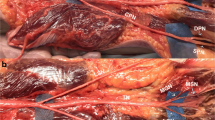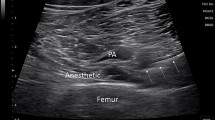Abstract
Background
Quadriceps palsy is mainly caused by proximal lesions in the femoral nerve. The obturator nerve has been previously used to repair the femoral nerve, although only a few reports have described the procedure, and the outcomes have varied. In the present study, we aimed to confirm the feasibility and effectiveness of this treatment in a rodent model using the randomized control method.
Methods
Sixty Sprague–Dawley rats were randomized into two groups: the experimental group, wherein rats underwent femoral neurectomy and obturator nerve transfer to the femoral nerve motor branch; and the control group, wherein rats underwent femoral neurectomy without nerve transfer. Functional outcomes were measured using the BBB score, muscle mass, and histological assessment.
Results
At 12 and 16 weeks postoperatively, the rats in the experimental group exhibited recovery to a stronger stretch force of the knee and higher BBB score, as compared to the control group (p < 0.05). The muscle mass and myofiber cross-sectional area of the quadriceps were heavier and larger than those in the control group (p < 0.05). A regenerated nerve with myelinated and unmyelinated fibers was observed in the experimental group. No significant differences were observed between groups at 8 weeks postoperatively (p > 0.05).
Conclusions
Obturator nerve transfer for repairing femoral nerve injury was feasible and effective in a rat model, and can hence be considered as an option for the treatment of femoral nerve injury.







Similar content being viewed by others
References
Jones KB, Ferguson PC, Deheshi B, Riad S, Griffin A, Bell RS, Wunder JS (2010) Complete femoral nerve resection with soft tissue sarcoma: functional outcomes. Ann Surg Oncol 17(2):401–406
Kim DH, Murovic JA, Tiel RL, Kline DR (2004) Intrapelvic and thigh level femoral nerve lesions: management and outcomes in 119 surgically treated cases. J Neurosurg 100(6):989–996
Bertelli JA, Soldado F, Rodríguesbaeza A, Ghizoni MF (2017) Transfer of the motor branch of the abductor digiti quinti for thenar muscle reinnervation in high median nerve injuries. J Hand Surg Am 41(1):8–15
Hu CH, Chang TN, Lu JC, Laurence VG, Chuang DC (2018) Comparison of surgical strategies between proximal nerve graft and/or nerve transfer and distal nerve transfer based on functional restoration of elbow flexion: a retrospective review of 147 patients. Plast Reconstr Surg 141(1):68e–79e
Iorio ML, Felder JM, Ducic I (2011) Anterior branch of the obturator nerve: a novel motor autograft for complex peripheral nerve reconstruction. Ann Plast Surg 67(3):260–262
Tsuchihara T, Nemoto K, Arino H, Amako M, Murakami H, Yoshizumi Y (2008) Sural nerve grafting for long defects of the femoral nerve after resection of a retroperitoneal tumour. J Bone Joint Surg Br 90(8):1097–1100
Yin G, Chen H, Hou C, Xiao J, Lin H (2016) Obturator nerve transfer to the branch of the tibial nerve innervating the gastrocnemius muscle for the treatment of sacral plexus nerve injury. Neurosurgery 78(4):546–551
Spiliopoulos K, Williams Z (2011) Femoral branch to obturator nerve transfer for restoration of thigh adduction following iatrogenic injury. J Neurosurg 114(6):1529–1533
Goubier JN, Teboul F, Yeo S (2012) Transfer of two motor branches of the anterior obturator nerve to the motor portion of the femoral nerve: an anatomical feasibility study. Microsurgery 32(6):463–465
Tung TH, Chao A, Moore AM (2012) Obturator nerve transfer for femoral nerve reconstruction: anatomic study and clinical application. Plast Reconstr Surg 130(5):1066–1074
Barrett MD, Nguyen DQ, Boyce DE (2011) Intra-abdominal femoral nerve reconstruction following excision during right hemicolectomy. J Plast Reconstr Aesthet Surg 64(12):1689–1692
Campbel AA, Eckhauser FE, Belzberg A, Campbell JN (2010) Obturator nerve transfer as an option for femoral nerve repair: case report. Neurosurgery 66(6 Suppl):375
Inaba N, Sato K, Suzuki T, Iwamoto T, Ochi K, Nakamura M, Matsumoto M, Toyama Y (2018) Partial obturator nerve transfer for femoral nerve injury: a case report. J Orthop Sci 23(1):202–204
Basso DM, Beattie MS, Bresnahan JC (1995) A sensitive and reliable locomotor rating scale for open field testing in rats. J Neurotrauma 12(1):1–21
Gang Y, Wang T, Sheng J, Hou C, Lin H (2014) Anatomical feasibility of transferring the obturator and genitofemoral nerves to repair lumbosacral plexus nerve root avulsion injuries. Clin Anat 27(5):783–788
Houdek MT, Wagner ER, Wyles CC, Moran SL (2014) Anatomical feasibility of the anterior obturator nerve transfer to restore bowel and bladder function. Microsurgery 34(6):459–463
Lin H, Hou C, Chen A, Xu Z (2011) Transfer of the phrenic nerve to the posterior division of the lower trunk to recover thumb and finger extension in brachial plexus palsy. J Neurosurg 114(1):212–216
Siqueira MG, Martins RS (2009) Phrenic nerve transfer in the restoration of elbow flexion in brachial plexus avulsion injuries: how effective and safe is it? Neurosurgery 65(4 Suppl):A125–A131
Snela S, Rydzak B (2002) The value of the adductor tenotomy with obturator neurectomy in the treatment of the hips at cerebral palsy children. Early clinical and radiological examination results. Ortop Traumatol Rehabil 4(1):11–14
Yun AG, Severino R, Reinker K (2005) Varus derotational osteotomy for spastic hip instability: the roles of femoral shortening and obturator neurectomy. Am J Orthop 34(2):81–85
Funding
This work was supported by the Program of Outstanding Medical Talent of Shanghai Municipal Health Bureau [grant number 2017BR034], the Shuguang Program of Shanghai Education Development Foundation and Shanghai Municipal Education Commission [grant number 15SG34], and the Project of Research Doctor of Changzheng Hospital [grant number 201712]. The sponsors had no role in the design or conduct of this research.
Author information
Authors and Affiliations
Corresponding author
Ethics declarations
Conflict of interest
The authors declare that they have no conflict of interest.
Ethical approval
All procedures performed in studies involving animals were in accordance with the ethical standards of the institution or practice at which the studies were conducted.
Additional information
Comments
For the past 40 years, nerve transfers have been used to restore function following injuries to the upper brachial plexus. At the present time, these transfers have a very high success rate. What I find most interesting is that through plasticity, the brain adapts to the new wiring circuit following the nerve transfer to effortlessly restore function.
While there are a few reports in the literature, nerve transfers have not been as frequently employed for injuries in the lower extremities. The authors explore the feasibility of transferring the proximal obturator nerve to the distal femoral nerve in rats. While the author’s measurements of success are indirect, they are compelling. This transfer could be employed under very specific circumstances in humans. As the femoral and obturator nerves run so close together in the pelvis, it would be an unusual injury that produced an injury to the femoral nerve that could not be repaired using nerve grafts but left the obturator nerve intact.
I was impressed by the fact that the three branches of the rat obturator nerve the authors anastomosed to the femoral nerve seemed to cover the cut surface of the femoral nerve. In humans, the obturator nerve is much smaller than the femoral nerve. Once the obturator nerve leaves the pelvis, there are two distinct branches which take relatively disparate courses and would need to be dissected for a distance in order to obtain enough length to transpose to the femoral nerve. It should be noted that in humans, the important motor branches to the quadriceps coming off the femoral nerve are already segregated to the posterior aspect of the nerve. Thus, if a surgeon were to attempt this anastomosis, I would recommend that the smaller obturator branches be attached to the posterior aspect of the femoral stump.
I congratulate the authors on a well-performed laboratory experiment.
Allan Friedman
North Carolina, USA
Electronic supplementary material
Online Resource 1
The video which was made at 16 weeks after the surgery. It demonstrated the stretch strength of the knee recovered after the surgery. (MP4 5213 kb)
Rights and permissions
About this article
Cite this article
Meng, D., Zhou, J., Lin, Y. et al. Transfer of obturator nerve for femoral nerve injury: an experiment study in rats. Acta Neurochir 160, 1385–1391 (2018). https://doi.org/10.1007/s00701-018-3565-1
Received:
Accepted:
Published:
Issue Date:
DOI: https://doi.org/10.1007/s00701-018-3565-1




